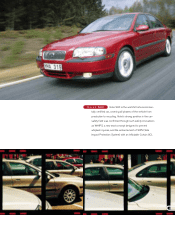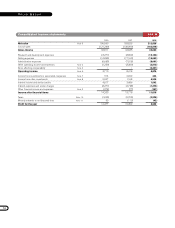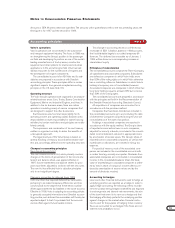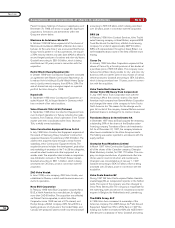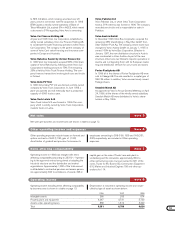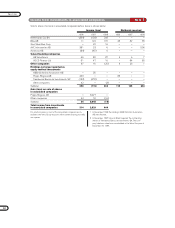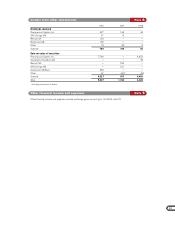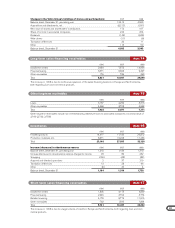Volvo 1998 Annual Report Download - page 57
Download and view the complete annual report
Please find page 57 of the 1998 Volvo annual report below. You can navigate through the pages in the report by either clicking on the pages listed below, or by using the keyword search tool below to find specific information within the annual report.
55
NOTES TO CONSOLIDATED FINANCIAL STATEMENTS
Amounts in SEK M unless otherwise specified. The amounts within parentheses refer to the two preceding years; the
first figure is for 1997 and the second for 1996.
This change in accounting results in a deferred tax
receivable of SEK 1.3 billion, based on 1998 accounts,
that is attributable largely to so-called temporary dif-
ferences. The deferred tax receivable as of January 1,
1999 will be shown as a corresponding increase in
shareholders’ equity.
Principles of consolidation
The consolidated accounts comprise the Parent Company,
all subsidiaries and associated companies. Subsidiaries
are defined as companies in which Volvo holds more
than 50% of the voting rights or in which Volvo otherwise
has a controlling influence. Subsidiaries in which Volvo’s
holding is temporary are not consolidated, however.
Associated companies are companies in which Volvo has
long-term holdings equal to at least 20% but not more
than 50% of the voting rights.
The consolidated accounts are prepared in accordance
with the principles set forth in the Recommendation of
the Swedish Financial Accounting Standards Council.
All acquisitions of companies are accounted for in
accordance with the purchase method.
Companies that have been divested are included in
the consolidated accounts up to and including the date
of divestment. Companies acquired during the year are
consolidated as of the date of acquisition.
Holdings in associated companies are reported in
accordance with the equity method. The Group’s share
of reported income before taxes in such companies,
adjusted for minority interests, is included in the consoli-
dated income statement, reduced in appropriate cases
by amortization of excess values. The Group’s share of
reported taxes in associated companies, as well as esti-
mated taxes in allocations, are included in Group tax
expense.
For practical reasons, most of the associated com-
panies are included in the consolidated accounts with
a certain time lag, normally one quarter. Dividends from
associated companies are not included in consolidated
income. In the consolidated balance sheet, the book
value of shareholdings in associated companies is affect-
ed by Volvo’s share of company’s income after tax, re-
duced by amortization of excess values and by the
amount of dividends received.
Accounting for hedges
Loans and other financial instruments used to hedge an
underlying position are reported as a hedge. In order to
apply hedge accounting, the following criteria must be
met: the position being hedged is identified and exposed
to exchange-rate and interest-rate movements, the aim
of the loan/instrument is to serve as a hedge and that
the hedging effectively protects the underlying position
against changes in the market rates. Financial instru-
ments used for the purpose of hedging future currency
flows are accounted for as hedges if the flows are con-
sidered most probably to occur.
Volvo’s operations
Volvo’s operations are concentrated in the automotive
and transport equipment industry. The focus in1998 was
on strengthening the Group’s position in the passenger
car field and developing its position as one of the world’s
leading manufacturers of trucks, buses, construction
equipment and drive systems for marine and industrial
applications. In the aircraft engine field Volvo has sub-
stantial resources for the maintenance of engines and
the development of engine components.
The consolidated accounts for AB Volvo and its sub-
sidiaries are prepared in accordance with Swedish
accounting principles. These principles differ in certain
significant aspects from general accepted accounting
principles in the US. (see Note 31).
Operating structure
The Volvo Group’s operations are organized in six product-
related business areas: Cars, Trucks, Buses, Construction
Equipment, Marine and Industrial Engines, and Aero. In
addition to the six business areas, there are certain
operations consisting mainly of service companies that
are designed to support the other businesses.
Each business area has total responsibility for its
operating income and operating capital. Business area
responsibilities include responsibility for sales-financing
activities, but certain restrictions and principles are estab-
lished centrally.
The supervision and coordination of tax and treasury
matters is organized centrally to obtain the benefits of
a Groupwide approach.
The legal structure of the Volvo Group is based on
optimal handling of treasury, tax and administrative mat-
ters and, accordingly, differs from the operating structure.
Changes in accounting principles
New Annual Accounts Act
The new Annual Accounts Act, which primarily involves
changes in the forms of presentation of the income sta-
tement and balance sheet, was applied effective in
1997. Income statements and balance sheets for prior
years have been adjusted to conform with the new rules.
The new Act has affected Volvo’s valuation principles
only to an insignificant degree.
Change in accounting for deferred taxes 1999
Until now, Volvo has reported deferred tax receivables
pertaining to so-called temporary differences and loss
carryforwards to the degree that these items could be
offset against deferred tax liabilities in the same tax area.
Effective in 1999, Volvo is adapting its accounting policies
to generally accepted international and Swedish accoun-
ting practice, and deferred tax receivables will thereby be
reported subject to that it is probable that the amounts
can be offset against future taxable income.
Accounting principles Note 1


